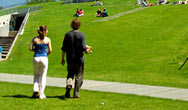
Delft University library roof
If you are building off-grid, or simply changing the roof on your existing home, consider a sedum roof or “green roof“. It transforms the feeling of a building as well as the appearance. You suddenly remember how closely we are connected to the world around us.
This is the best book on the practical aspects of greening your roof. In hot weather, the surface temperature of a green roof is cooler than the surrounding air ” compare that to a traditional roof surface which can be up to 90″F (50″C) hotter. In the cold, the additional insulating properties still come to the fore.
The installation cost is around $8 per square foot.
This price includes the preparation work, materials, and installation. And remember the green roof is installed on top of an existing waterproof finish. A traditional roof can start as low as $1.25 plus installation and cool roof membrane costs only $1.50 per square foot.
The Intensive Green Roof is characterized by:
Minimum soil depth of one foot.
Can accommodate large trees, shrubs, and well-maintained gardens.
An additional 80-150 pounds weight per square foot of load to building structure.
Regular public access is encouraged and accommodated for.
Requires extensive maintenance, as with any garden type.
As with any large container garden it must include a complex irrigation and drainage system.
The Extensive Green Roof is characterized by:
Only needs 1 to 5 inches of soil depth.
Is just capable of including any vegetative ground cover and grasses.
Additional weight is only 12-50 pounds per square foot, depending on soil characteristics and the type of substrate.
Not designed for public access nor accommodated for.
Only annual maintenance walks need to fill in bare spots with plants.
Simple irrigation and drainage systems are used.
Green roofs have vegetation and soil, or another growing medium planted over a waterproof material. Some roofs also include additional layers of a root barrier, drainage, and/or irrigation system.
They can be incorporated into most types of buildings, and are widely used in Europe for their great storm water management, energy saving ability, and beauty.
Additional benefits include:
Reducing flooding by soaking up large amounts of rainwater.
Absorbing air pollution, store carbon, and they collect airborne particulates.
Eliminating exposure of the sun”s ultraviolet radiation and daily temperature
extremes which will protect the underlying roofing material.
It can serve as habitats for birds and other small animals.
Can help address the growing concerns about urban quality of life.
Improve noise reduction from outside sources.
Insulate a building from extreme temperatures, especially in summer, which helps
keep the building interior cool.
As buildings, pavements, roads, and other impermeable surfaces replace open fields and vegetation, this roofing option can play an important role in storm water management. During storms they can absorb much of the water that would otherwise run off. It is estimated that 3-5 inches of soil or another growing medium can absorb 75% of a rain event of 1/2 inch or less.
While absorbing this rainwater it also filters the pollution out of it. This is done by the bacteria and fungi in the root system, utilizing the natural filtering process. This results in nitrogen and phosphorous being broken down and detoxified. Over time this process will only increase as the plants and root system mature on the roof.
Green roofs are available in two types, Intensive Green Roof and Extensive Green Roof.
Since these roofs require more material and labor for installation the price would of course be higher than a typical roof. Also as green roof contractor are at premium, i.e. limited, they are harder to come by.
As with any alternative and energy saving building process the up-front cost cannot tell the whole story. If you take into account your energy savings, the limited damage to your roof substrate and the enjoyment of having your own little patch in an urban area, the cost is relative in the long run.